Ernst Klimt
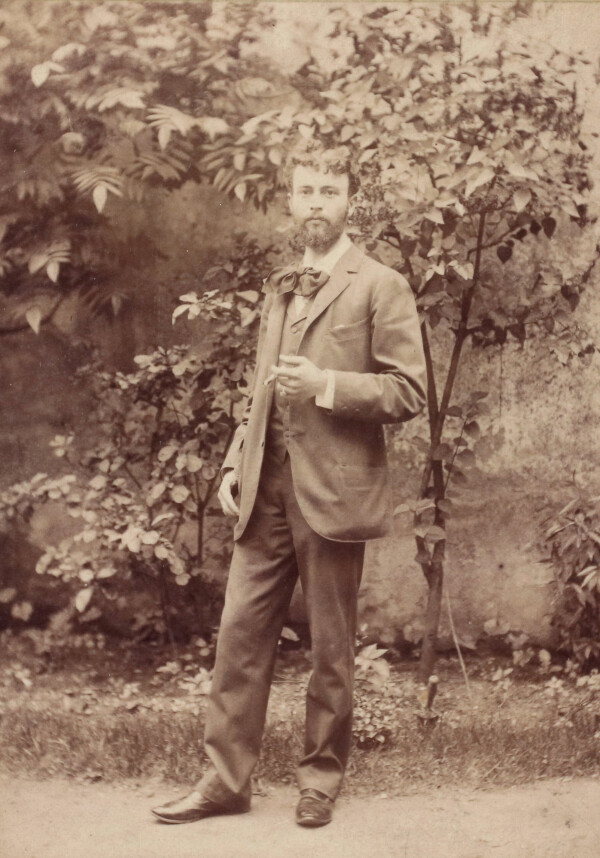
Ernst Klimt photographed by Carl Schuster (detail), probably 1892
© Klimt Foundation, Vienna
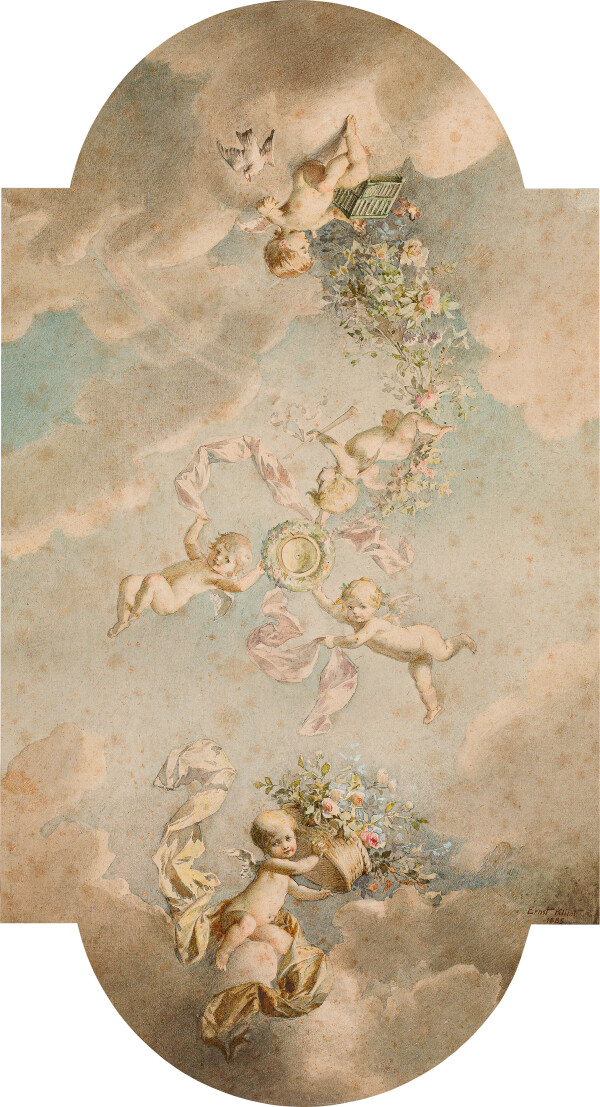
Ernst Klimt: Putti with Garlands of Roses, unfinished design for a ceiling painting, presumably for a decorative commission by the Künstler-Compagnie for the Stadttheater in Karlsbad, 1885, Klimt Foundation, Vienna
© Klimt Foundation, Vienna
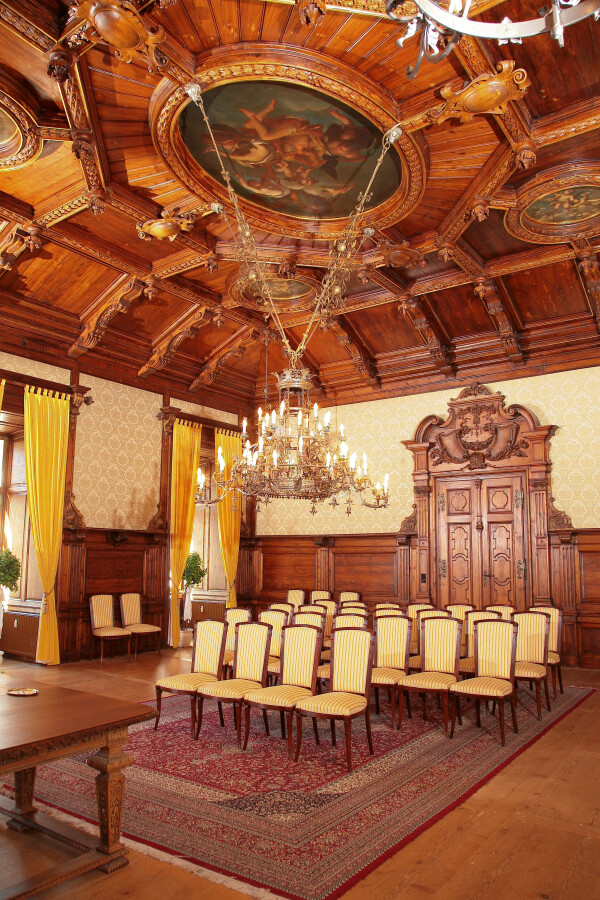
Ernst Klimt: Ceiling painting in the Prince's Room of Mondsee Castle (today: registry office)
© Marktgemeinde Mondsee
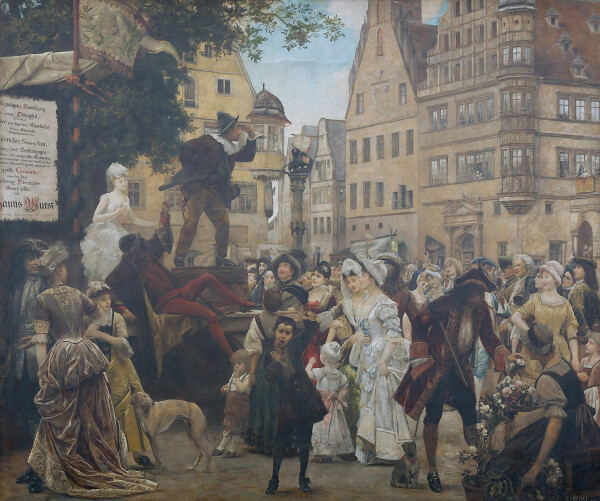
Ernst Klimt: Hanswurst on the fairground stage, 1886-1888, Burgtheater Vienna
© Georg Soulek
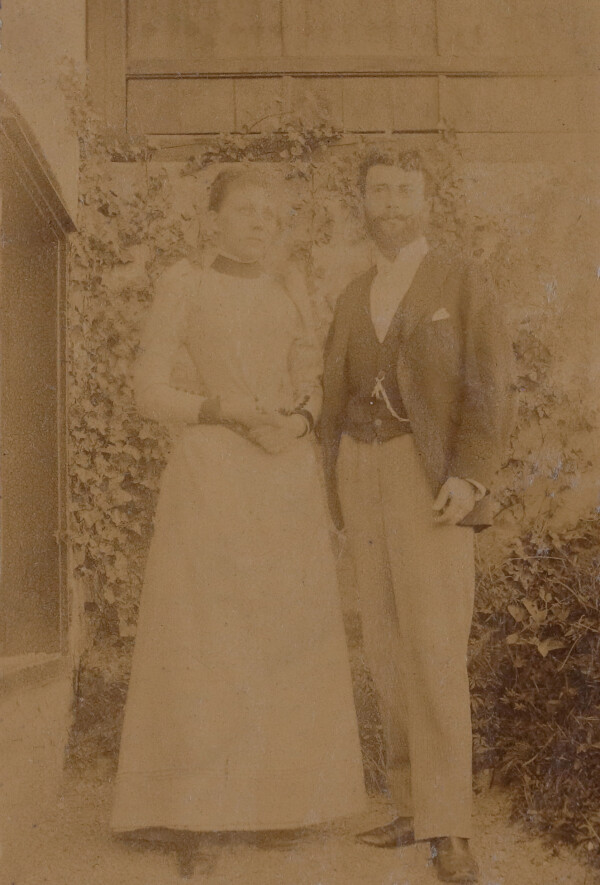
Helene and Ernst Klimt, around 1891
© Klimt Foundation, Vienna
Together with his brother Gustav Klimt and their fellow artist Franz Matsch, Ernst Klimt was among the most influential decorative painters in Vienna around 1900. The most important commissions they received with their artists’ collective, the “Künstler-Compagnie,” included the ceiling paintings for the Vienna Burgtheater and the spandrel paintings for the stairwell of the Kunsthistorisches Museum.
Ernst Klimt was born in Penzing near Vienna on 3 January 1864 as the third of seven children of the Bohemian gold engraver Ernest Klimt sen. and Anna Klimt (née Finster) from Vienna.
Like his brother Gustav, who was two years older than him, Ernst also had great artistic talent. Together, the brothers studied at the Imperial-Royal School of Arts and Crafts (now University of Applied Arts Vienna) of the Austrian Museum of Art and Industry (now MAK) from 1875. Their teachers included Michael Rieser, Ferdinand Julius Laufberger and Julius Victor Berger. During their studies the brothers met Franz Matsch. Encouraged by their teachers, the three talented young artists decided to collaborate on their commissions in the future. This was the beginning of the artists’ collective habitually referred to as the “Künstler-Compagnie” in relevant research.
Ernst Klimt and the “Künstler-Compagnie”
Ferdinand Laufberger soon realized the extraordinary talents of the Klimt brothers, who had originally intended to train as drawing teachers. A scholarship enabled the young artists to join the Drawing and Painting Class in 1878. Furthermore, they were given the opportunity to contribute to commissions of their teachers. For the professors Rieser, Laufberger and Berger, they created window designs for the Votivkirche, cardboard templates for sgraffiti in the courtyard of the Kunsthistorisches Museum [Imperial-Royal Museum of Art History] as well as ceiling paintings for the bedroom of Empress Elisabeth in the Hermesvilla near Lainz. The close collaboration of the Klimt brothers and Franz Matsch in this early period makes any individual attributions almost impossible. In the 1880s, the rising artists contributed to Allegorien und Embleme, a comprehensive collection of templates published by Gerlach & Schenk.
The three painters executed their first independent commissions under the patronage of the two architects Ferdinand Fellner and Hermann Helmer. Between 1882 and 1892, they created many ceiling paintings for private palaces in Vienna as well as decorations and curtains for concert halls and theaters in the province, such as the city theater in Karlsbad (now Karlovy Vary).
The distribution of work within these projects shows that Ernst frequently took a subordinate role compared to his brother and Franz Matsch. While Gustav Klimt and Matsch designed the overall concepts of the ceiling and curtain paintings, Ernst’s contribution was mostly limited to smaller individual figures and peripheral works, such as the proscenium paintings for theaters. The two older artists were also primarily in charge of corresponding with clients: Ernst Klimt’s signature is found only rarely on letters.
The painters moved into their first independent studio at Sandwirtgasse 8 in 1883. Around this time, Ernst took on his first major independent commission. Working alone, he created five ceiling paintings for the so-called Regency Room at Mondsee Castle in Upper Austria.
Ernst Klimt and Gustav Klimt at a Stylistic Crossroads
The most prestigious commissions to which Ernst Klimt contributed in the context of the “Künstler-Compagnie” included the artistic decorations for the Vienna Burgtheater created between 1886 and 1888 (for which he received the Golden Cross of Merit with Crown in 1888) as well as the spandrel paintings in the Kunsthistorisches Museum created in 1890/1891. Of the total of ten ceiling paintings in the Burgtheater, Ernst painted the two depictions Hanswurst on the Fair Stage (1886–1888, Burgtheater, Vienna) and Scene of Molière (1886–1888, Burgtheater, Vienna). The paintings for the stairwell of the Kunsthistorisches Museum, in particular, illustrate the diverging stylistic development of the two brothers. While Ernst continued to adopt a Historicist style in his three spandrel paintings, Gustav’s paintings show more and more symbolist elements and antique references. At the same time, works such as Francesca da Rimini and Paolo (around 1890, Austrian Gallery Belvedere, Vienna) show that beyond his commissions for decorations, Ernst was increasingly turning towards the style of the Pre-Raphaelites in his paintings.
On 7 September 1891, Ernst Klimt married Helene Flöge, the daughter of a highly respected factory owner. The wedding was a life-changing event not only for Ernst Klimt; it would also change the life of his brother Gustav, who met Emilie Flöge (Helene’s sister, who was three years older than her). She would become an important confidant for Gustav Klimt.
Ernst’s daughter Helene Klimt jun. (m. Donner), lovingly called “Lentschi,” was born on 28 July 1892. Ernst unexpectedly died from heart failure in December of the same year. Aged only 29, the painter was survived by his young widow and his barely five-month-old daughter, of whom Gustav assumed guardianship.
Shortly before his death, Ernst had been working on the painting Hanswurst Delivering an Impromptu Performance in Rothenburg (around 1892–1894, privately owned), which was based on the scene in the stairwell of the Burgtheater. The work was presumably a private commission. Since Ernst had left the painting unfinished, Gustav completed his brother’s work. He used several family members as models, including Ernst’s wife Helene Klimt. The painting was posthumously exhibited under Ernst Klimt’s name at the “XXIII. Jahresausstellung der Genossenschaft der bildenden Künstler Wiens” [“23rd Annual Exhibition of the Cooperative of Visual Artists in Vienna”] at the Vienna Künstlerhaus in 1895.
Literature and sources
- Sandra Tretter, Hans-Peter Wipplinger (Hg.): Gustav Klimt. Jahrhundertkünstler, Ausst.-Kat., Leopold Museum (Vienna), 22.06.2018–04.11.2018, Vienna 2018.
- Herbert Giese: Franz von Matsch – Leben und Werk. 1861–1942. Dissertation, Vienna 1976.
- Mona Horncastle, Alfred Weidinger: Gustav Klimt. Die Biografie, Vienna 2018.
- Otmar Rychlik: Gustav Klimt Franz Matsch und Ernst Klimt im Kunsthistorischen Museum, Vienna 2012.
- Brief von Franz Matsch in Wien an den Magistrat der Stadt Reichenberg, mitunterschrieben von Gustav Klimt (vor dem 11.10.1883). VI. – Gd, 202, Signatur 709/4, Karton 188_13, .
- Christian M. Nebehay (Hg.): Gustav Klimt. Dokumentation, Vienna 1969, S. 18-25.
- Sterbebuch 1892/93 (Tomus 56), röm.-kath. Pfarre St. Ulrich, Wien, fol. 42.
- Sammlung Belvedere. Ernst Klimt. sammlung.belvedere.at/people/1063/ernst-klimt (02/24/2022).
- Klassenkataloge 1876–1881, .
- Agnes Husslein-Arco (Hg.): Gustav Klimt und die Künstler-Compagnie, Ausst.-Kat., Upper Belvedere (Vienna), 20.06.2007–14.10.2007, Weitra 2007.

